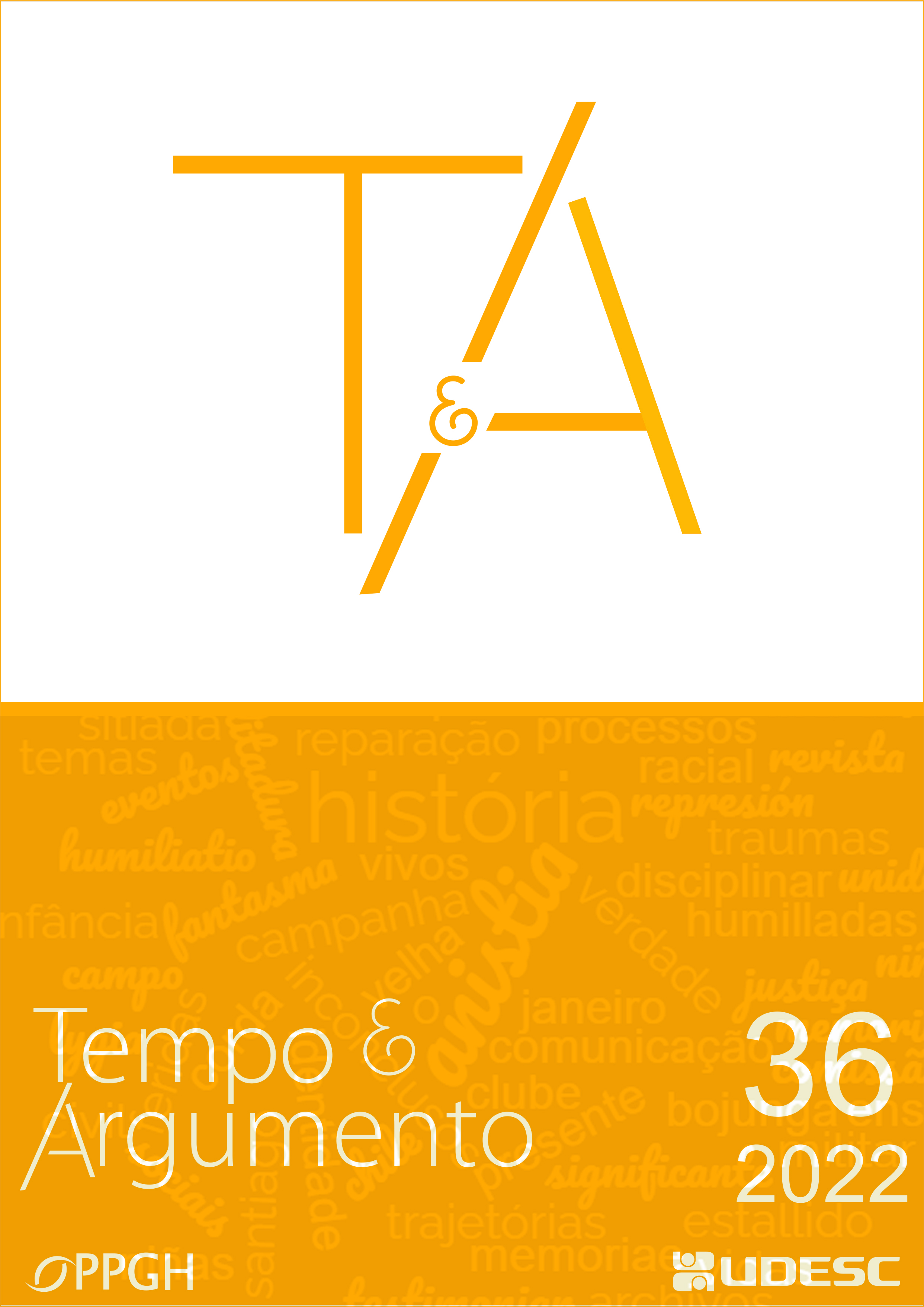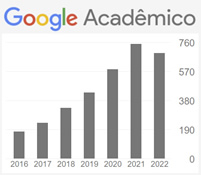The unwanted of the 21st century: unaccompanied children detained at the US-Mexico border
DOI:
https://doi.org/10.5965/2175180314362022e0302Keywords:
international migration, children, borders Mexico-UnitedStates, immigration, unauthorized migrationAbstract
At the end of the 20th century, there was an increase in the perception, in the international community, of the movement of migrant workers, of flows of people in search of a better life and who were faced with increasingly restrictive migratory policies. In this scenario, there has been a growth in children who migrate alone or unaccompanied by their parents, held back at the borders. Thus, although, in demographic terms, we cannot speak of an expansion of migrant flows, as international rates are around 3%, the media narratives about these flows build a discourse of “invasion”, of threat, spreading moral panic in relation to these flows. to immigrants, contributing to their being treated with prejudice and discrimination. Thus, immigrants and refugees, including unaccompanied children, constitute a “new” category of undesirables that emerges at the beginning of this century. The objective of this article is to understand, from the production that crosses perspectives of Transnational History, Anthropology of Mobilities and Sociology, the fear of the “other”, which translates into increasingly harsh and restrictive surveillance systems, which led to the increased incarceration of unaccompanied children and adolescents at borders. The article analyzes children separated from their families on the border between Mexico and the United States, in shelters and transit centers, where they are placed in a situation similar to that of prisons, as they are incarcerated. The sources are a bibliographic survey on unaccompanied children, articles found in the press, IOM and UN data on the incarceration of children, through which we seek to understand the contexts in host societies that produce hierarchies between desirable and undesirable migrants.
Downloads
References
AQUINO MORESCHI, Alejandra. Porque si llamas al miedo, el miedo te friega: la ilegalización de los trabajadores migrantes y sus efectos en las subjetividades. Estudios fronterizos, [Mexicali], v. 16, n. 32, p. 75-98, 2015.
ASSIS, Gláucia O. The Mexico-United States border: between the dream and the nightmare-the experiences of emigrants/immigrants in non-authorized trips in the global world. Cadernos Pagu, Campinas, n. 31, p. 219-250, 2008.
AUGÉ, Marc. Por uma antropologia da mobilidade. Maceió: Edufal: Unesp, 2010.
ANZALDÚA, Gloria. Borderlands: the new mestiza=la frontera. Madrid: Capitan Swing Libros, Collecion Ensaio, 2016. 308 p.
BASSANEZI, Maria Silvia Carla. Crianças a caminho: imigrantes e filhas de imigrantes nas terras paulistas. In: SIMPÓSIO NACIONAL DE HISTÓRIA, 27., 2013, Natal. Anais [...]. [S.l.]: ANPUH, 2013. p. 1-17.
BAUMAN, Zygmunt. A globalização e as consequências humanas. Rio de Janeiro: Jorge Zahar Editor, 1999.
BHABHA, Jacqueline; SCHMIDT, Susan. Seeking asylum alone: unaccompanied and separated children and refugee protection in the US. The Journal of the History of Childhood and Youth, Guelph, v. 1, n. 1, p. 126-138, 2008.
BRANT, Danielle. EUA mantêm 12.800 crianças migrantes em abrigos em setembro. Folha de S. Paulo, São Paulo, 12 set. 2018. Mundo. https://www1.folha.uol.com.br/mundo/2018/09/apreensoes-de-familias-imigrantes-na-fronteira-sul-dos-eua-batem-recorde.shtml. Acesso em: 1 jul. 2021.
BUSCH, Laura. Opinion: separating children from their parents at the border ‘breaks my heart’. Washington Post, Washington, 17 June 2018. Disponível em: https://www.washingtonpost.com/opinions/laura-bush-separating-children-from-their-parents-at-the-border-breaks-my-heart/2018/06/17/f2df51 . Acesso em: 05 abr. 2020.
CARAZZAI, Estelita Hass. Tolerância zero com migrantes nos EUA leva a 'julgamentos expressos'. Folha de S. Paulo, São Paulo, 24 jun. 2018. Mundo. Disponível em https://www1.folha.uol.com.br/mundo/2018/06/tolerancia-zero-com-migrantes-nos-eua-leva-a-julgamentos-expressos.shtml - Mundo - Folha (uol.com.br). Acesso em: 05 abr. 2020.
COMO SÃO as “jaulas” em que os EUA estão detendo filhos de imigrantes sem documentos. Folha de S. Paulo, São Paulo, 19 jun. 2018. Mundo. Disponível em: https://www1.folha.uol.com.br/mundo/2018/06/como-sao-as-jaulas-em-que-os-eua-estao-detendo-filhos-de-imigrantes-sem-documentos.shtml (uol.com.br). Acesso em: 05 abr. 2021.
CHISHTI, Muzaffar; BOLTER, Jessica. Family separation and “zero-tolerance” policies rolled out to stem unwanted migrants, but may face challenges. Migration Policy Institute, Washington, 24 May. 2018. Disponível em: https://www.migrationpolicy.org/article/family-separation-and-zero-tolerance-policies-rolled-out-stem-unwanted-migrants-may-face. Acesso em: 12 jul. 2020.
COHN, D’Vera; PASSEL, Jeffrey S.; GONZALEZ-BARRERA, Ana. Rise in U.S. immigrants from El Salvador, Guatemala and Honduras outpaces growth from elsewhere. PEW Pew Research Center, Washington 7 Dec. 2017. Disponível em: http://www.pewhispanic.org/2017/12/07/rise-in-u-s-immigrants-from-el-salvador-guatemala-and-honduras-outpaces-growth-from-elsewhere. Acesso em: 20 maio 2021.
CURCI, Natália Benatti Zardo. Jovens migrantes transnacionais na escola: o que (não) nos contam? Dissertação (Mestrado em Educação) − UFSC, Florianópolis, 2020, 20 p.
DESENHOS de crianças imigrantes mostram centros de detenção dos EUA como prisões. Folha de S. Paulo. 03 jul. 2019. Mundo Disponível em: https://www1.folha.uol.com.br/mundo/2019/07/desenhos-de-criancas-imigrantes-mostram-centros-de-detencao-dos-eua-como-prisoes.shtml. Acesso em: 01 de jul. 2021.
DONATO, Katharine M.; PEREZ, Samantha L. Crossing the Mexico-US border: Illegality and children’s migration to the United States. RSF: The Russell Sage Foundation Journal of the Social Sciences, Baltimore, v. 3, n. 4, p. 116-135, 2017.
FORNER, Nancy. From Ellis Island to JFK; New York's great wave of immigration. New Haven: Yale University Press, 2000.
GERALDO, Endrica. A “lei de cotas” de 1934: controle de estrangeiros no Brasil. Cadernos AEL, Campinas, v. 15, n. 27, p. 173-208, 2009. Disponível em: https://www.ifch.unicamp.br/ojs/index.php/ael/article/view/2575/1985. Acesso em: 05 abr. 2021.
GLICK SCHILLER, Nina. Theorising transnational migration in our times: A multiscalar temporal perspective. Nordic Journal of Migration Research, Helsinki, v. 8, n. 4, p. 201-212, 2018.
GLICK SCHILLER, Nina. Explanatory frameworks in transnational migration studies: the missing multi-scalar global perspective. Ethnic and Racial Studies, Guildford, v. 38, n. 13, p. 2275-2282, 2015.
FASSIN, Didier. Compaixão e repressão: a economia moral das políticas de imigração na França. Ponto Urbe. Revista do núcleo de antropologia urbana da USP, São Paulo, p. 29, 2014. Disponível em: https://journals.openedition.org/pontourbe/2467. Acesso em: 5 maio 2022.
FASSIN, Didier. Policing borders, producing boundaries: the governmentality of immigration in dark times. Annual Review of anthropology, Palo Alto, v. 40, n. 1, p. 213-226, 2011.
FASSIN, Didier. Clandestins ou exclus?:quand les mots font les politiques. Politix, Revue des sciences sociales du politique [Paris], v. 34. p. 77-86, 1996. Disponível em https://www.persee.fr/doc/polix_0295-2319_1996_num_9_34_1032. Acesso em: 5 maio 2022.
GAITÁN, Lourdes et al. Los niños como actores en los procesos migratorios. Madrid: Universidad Complutense de Madrid, 2008.
HAESBAERT, Rogério. Des-controle dos territórios–e das fronteiras–num mundo globalizado. Geografia em Questão, Marechal Cândido Rondon, v. 2, n. 1, p. 56-69, 2009.
KEMPADOO, Kamala. Mudando o debate sobre o tráfico de mulheres Cadernos Pagu, Campinas: Núcleo de Estudos de Gênero: Pagu: Unicamp, v. 25, p. 55-79, jul./dez. 2005.
KOSELLECK, Reinhart. Estratos do tempo. Rio de Janeiro: Contraponto; PUC-Rio, 2014.
LIMA, Fernanda Da Silva. Crise humanitária internacional e os direitos das crianças migrantes ou refugiadas: uma análise da opinião consultiva nº 21 da Corte Interamericana de Direitos Humanos. Revista do Direito, Santa Cruz do Sul, v. 1, n. 51, p. 87-107, 2017.
MARTI, Silas. Caravana com imigrantes da América Central chega a Tijuana sob ameaças . Folha de S. Paulo, São Paulo, 24 mar. 2018. Disponível em: https://www1.folha.uol.com.br/mundo/2018/04/caravana-com-imigrantes-da-america-central-chega-a-tijuana-sob-ameacas.shtml. Acesso em: 05 abr. 2020.
MARTÍNEZ, Laura. Niñez, migración y derechos: aportes para un abordaje antropológico. Revista Sociedad y Equidad, Santiago, n. 6, p. 237-257, 2014.
MARTUSCELLI, Patrícia Nabuco. Crianças desacompanhadas na América Latina: reflexões iniciais sobre a situação na América Central. Revista Interdisciplinar de Direitos Humanos: RIDH, Bauru, v. 5, n. 1, p. 77-96, 2017.
MARTINS-BORGES, Lucienne. Migração involuntária como fator de risco à saúde mental. Revista Interdisciplinar da Mobilidade Humana: REMHU, Brasília, v. 21, n. 40, p. 151-162, jan/jun, 2013.
MENEZES, Lená Medeiros de. Os indesejáveis: desclassificados da modernidade. Rio de Janeiro, Eduerj, 1996.
PALUMMO, Javier, and Luciana Vaccotti (org.). Derechos humanos de la niñez migrante. 1. ed. Buenos Aires: Instituto de Políticas Públicas en Derechos Humanos (IPPDH) del MERCOSUR/OIM, 2016. 45 p.
PAVEZ-SOTO, Iskra. La niñez en las migraciones globales: perspectivas teóricas para analizar su participación. Tla-melaua, Revista de Ciencias Sociales, Puebla, v. 10, n. 41, p. 96-113, 2017.
PISCITELLI, Adriana; ASSIS, Gláucia de Oliveira and Olivar; NIETO, José Miguel. Gênero, sexo, amor e dinheiro: mobilidades transnacionais envolvendo o Brasil. Campinas: UNICAMP, 2011.
SCHWARCZ, Lilia Moritz; STARLING, Heloisa Murgel. A bailarina da morte: a gripe espanhola no Brasil. São Paulo: Companhia das Letras, 2020.
SCHWARZ, Tobias. Políticas de inmigración en América Latina: el" extranjero indeseable" en las normas nacionales, de la Independencia hasta los años de 1930. Procesos: revista ecuatoriana de historia, Quito, v. 36, p. 39-72. https://doi.org/10.29078/rp.v0i36.23 . Acesso em: 20 maio 2021
SEYFERTH, Giralda. Imigrantes, estrangeiros: a trajetória de uma categoria incomoda no campo político. Mesa redonda imigrantes e emigrantes: as transformações das relações do Estado Brasileiro com a migração. REUNIÃO BRASILEIRA DE ANTROPOLOGIA, 26., 2008, Porto Seguro. Anais [...]. [S.l.: s.n.], 2008. v. 1. p. 1-20. Disponível em: http://www.imigracaohistorica.info/uploads/ 1/3/0/0/130078887/seyferth_giralda._imigrantes_estrangeiros_a_trajet%C3%B3ria_de_uma_categoria_inc%C3%B4moda_no_campo_pol%C3%ADtico.pdf Acesso em: 22 maio 2021.
TRUMP diz que não fará acordo para regularizar imigrantes ilegais . Folha de S. Paulo, São Paulo, 01 abr. 2018. Mundo. Disponível em: https://www1.folha.uol.com.br/mundo/2018/06/tolerancia-zero-com-migrantes-nos-eua-leva-a-julgamentos-expressos.shtml. Acesso em: 10 mar. 2020.
VELASCO, Juan Carlos. De muros intransponíveis a fronteiras transitáveis. Revista Interdisciplinar da Mobilidade Humana: REMHU, Brasília, v. 27, p. 159-174, 2019.
VENTURA, Deisy de Freitas Lima et al. Desafios da pandemia de COVID-19: por uma agenda brasileira de pesquisa em saúde global e sustentabilidade. Cadernos de Saúde Pública, Rio de Janeiro, v. 36, p. e00040620, 2020.
VENTURA, Deisy de Freitas Lima. Do Ebola ao Zika: as emergências internacionais e a securitização da saúde global. Cad. Saúde Pública, Rio de Janeiro, v. 32, n. 4, e00033316, abr. 2016.
VIANNA, Adriana. El mal que se adivina: policía y minoridad en Río de Janeiro, 1910-1920. Buenos Aires: ADHOC, 2007.
Downloads
Published
How to Cite
Issue
Section
License
Copyright (c) 2022 Tempo e Argumento

This work is licensed under a Creative Commons Attribution-NonCommercial 4.0 International License.
The articles published by the magazine are for free use, destined for educational purposes and not commercial. The copyrights are all granted to the magazine. The articles whose authors are identified represent the expressed opinion of its authors and not the official position of the Tempo e Argumento magazine or of the Postgraduate Program in History of the Universidade do Estado de Santa Catarina.




